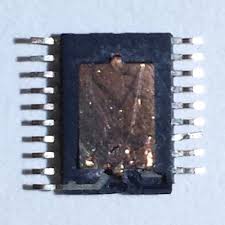We can Read Chip PIC16C715 Program, please view the Chip PIC16C715 features for your reference:
The USART can be configured in the following modes:
- Asynchronous (full-duplex)
- Synchronous – Master (half-duplex)
- Synchronous – Slave (half-duplex)
Bit SPEN (RCSTA<7>) and bits TRISC<7:6> have to be set in order to configure pins RC6/TX/CK/SCK/SCL/SEG9 and RC7/RX/DT/SDI/SDA/SEG8 as the Universal Synchronous Asynchronous Receiver Transmitter from program reading.
The USART module also has a multi-processor communication capability using 9-bit address detection. The BRG supports both the Asynchronous and Synchronous modes of the USART. It is a dedicated 8-bit baud rate generator.
The SPBRG register controls the period of a free running 8-bit timer. In Asynchronous mode, bit BRGH (TXSTA<2>) also controls the baud rate. In Synchronous mode, bit BRGH is ignored. Table 11-1 shows the formula for computation of the baud rate for different USART modes which only apply in Master mode (internal clock) after chip program reading.

Given the desired baud rate and FOSC, the nearest integer value for the SPBRG register can be calculated using the formula in Table 11-1. From this, the error in baud rate can be determined. It may be advantageous to use the high baud rate (BRGH = 1) even for slower baud clocks when read the chip program.
This is because the FOSC/(16 (X + 1)) equation can reduce the baud rate error in some cases. Writing a new value to the SPBRG register causes the BRG timer to be reset (or cleared). This ensures the BRG does not wait for a timer overflow before outputting the new baud rate if the chip program can be read.
The data on the RC7/RX/DT/SDI/SDA/SEG8 pin is sampled three times by a majority detect circuit to determine if a high or a low level is present at the RX pin. In this mode, the USART uses standard Non-Return-to-Zero (NRZ) format (one Start bit, eight or nine data bits and one Stop bit).
The most common data format is 8 bits. An on-chip, dedicated, 8-bit Baud Rate Generator can be used to derive standard baud rate frequencies from the oscillator to Break IC code. The USART transmits and receives the LSb first. The transmitter and receiver are functionally independent but use the same data format and baud rate .
The baud rate generator produces a clock, either x16 or x64 of the bit shift rate, depending on bit BRGH (TXSTA<2>). Parity is not supported by the hardware, but can be implemented in software (and stored as the ninth data bit). Asynchronous mode is stopped during Sleep.
Asynchronous mode is selected by clearing bit SYNC (TXSTA<4>). The USART Asynchronous module consists of the following important elements:
Baud Rate Generator
Sampling Circuit
Asynchronous Transmitter
Asynchronous Receiver

